Signals and Systems: Correlation, PSD, Modulation, and Noise
VerifiedAdded on 2020/04/01
|7
|1202
|264
Report
AI Summary
This report provides an analysis of signals and systems, delving into critical aspects such as correlation functions, power spectral density (PSD), and various modulation schemes including OOK, FSK, PSK, DPSK, and QAM. It explores the Wiener-Khinchine theorem and its application in spectral analysis. The report also discusses constellation diagrams, Gray code, and Double Side-Band modulation. Furthermore, it addresses thermal noise, multi-symbol signal transmission, modulation of low frequencies, and other modulation techniques like Multiple Frequency-Shift keying and Pulse-code modulation. The report also provides a detailed overview of each of these topics, offering valuable insights into the behavior and applications of signals and systems in communication engineering.

Running head: Signals and systems
1
Theory of Signals and Systems
Author
Course
Date
1
Theory of Signals and Systems
Author
Course
Date
Paraphrase This Document
Need a fresh take? Get an instant paraphrase of this document with our AI Paraphraser
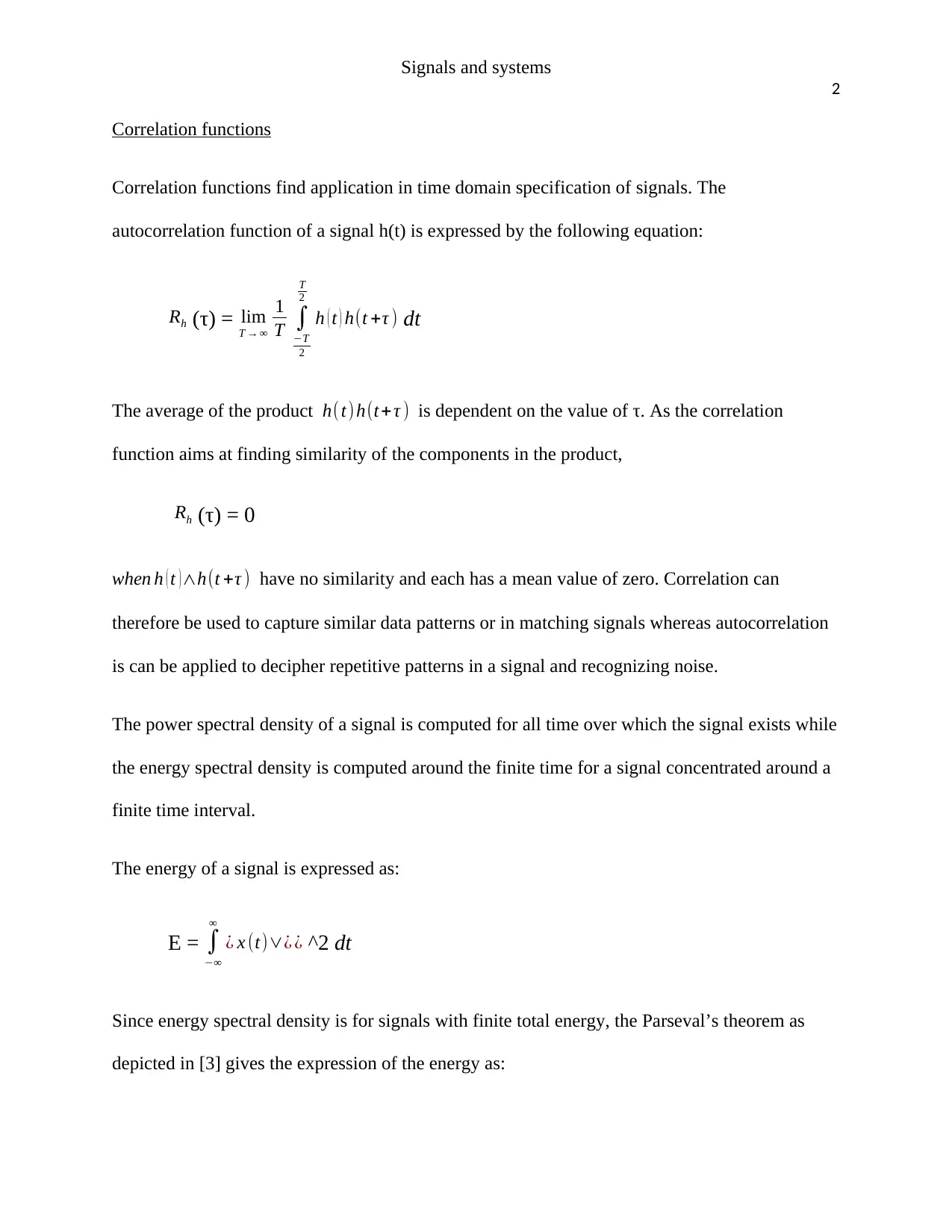
Signals and systems
2
Correlation functions
Correlation functions find application in time domain specification of signals. The
autocorrelation function of a signal h(t) is expressed by the following equation:
Rh (τ) = lim
T → ∞
1
T ∫
−T
2
T
2
h ( t ) h(t +τ ) dt
The average of the product h( t)h(t+τ ) is dependent on the value of τ. As the correlation
function aims at finding similarity of the components in the product,
Rh (τ) = 0
when h ( t ) ∧h(t +τ ) have no similarity and each has a mean value of zero. Correlation can
therefore be used to capture similar data patterns or in matching signals whereas autocorrelation
is can be applied to decipher repetitive patterns in a signal and recognizing noise.
The power spectral density of a signal is computed for all time over which the signal exists while
the energy spectral density is computed around the finite time for a signal concentrated around a
finite time interval.
The energy of a signal is expressed as:
E = ∫
−∞
∞
¿ x (t)∨¿ ¿ ^2 dt
Since energy spectral density is for signals with finite total energy, the Parseval’s theorem as
depicted in [3] gives the expression of the energy as:
2
Correlation functions
Correlation functions find application in time domain specification of signals. The
autocorrelation function of a signal h(t) is expressed by the following equation:
Rh (τ) = lim
T → ∞
1
T ∫
−T
2
T
2
h ( t ) h(t +τ ) dt
The average of the product h( t)h(t+τ ) is dependent on the value of τ. As the correlation
function aims at finding similarity of the components in the product,
Rh (τ) = 0
when h ( t ) ∧h(t +τ ) have no similarity and each has a mean value of zero. Correlation can
therefore be used to capture similar data patterns or in matching signals whereas autocorrelation
is can be applied to decipher repetitive patterns in a signal and recognizing noise.
The power spectral density of a signal is computed for all time over which the signal exists while
the energy spectral density is computed around the finite time for a signal concentrated around a
finite time interval.
The energy of a signal is expressed as:
E = ∫
−∞
∞
¿ x (t)∨¿ ¿ ^2 dt
Since energy spectral density is for signals with finite total energy, the Parseval’s theorem as
depicted in [3] gives the expression of the energy as:
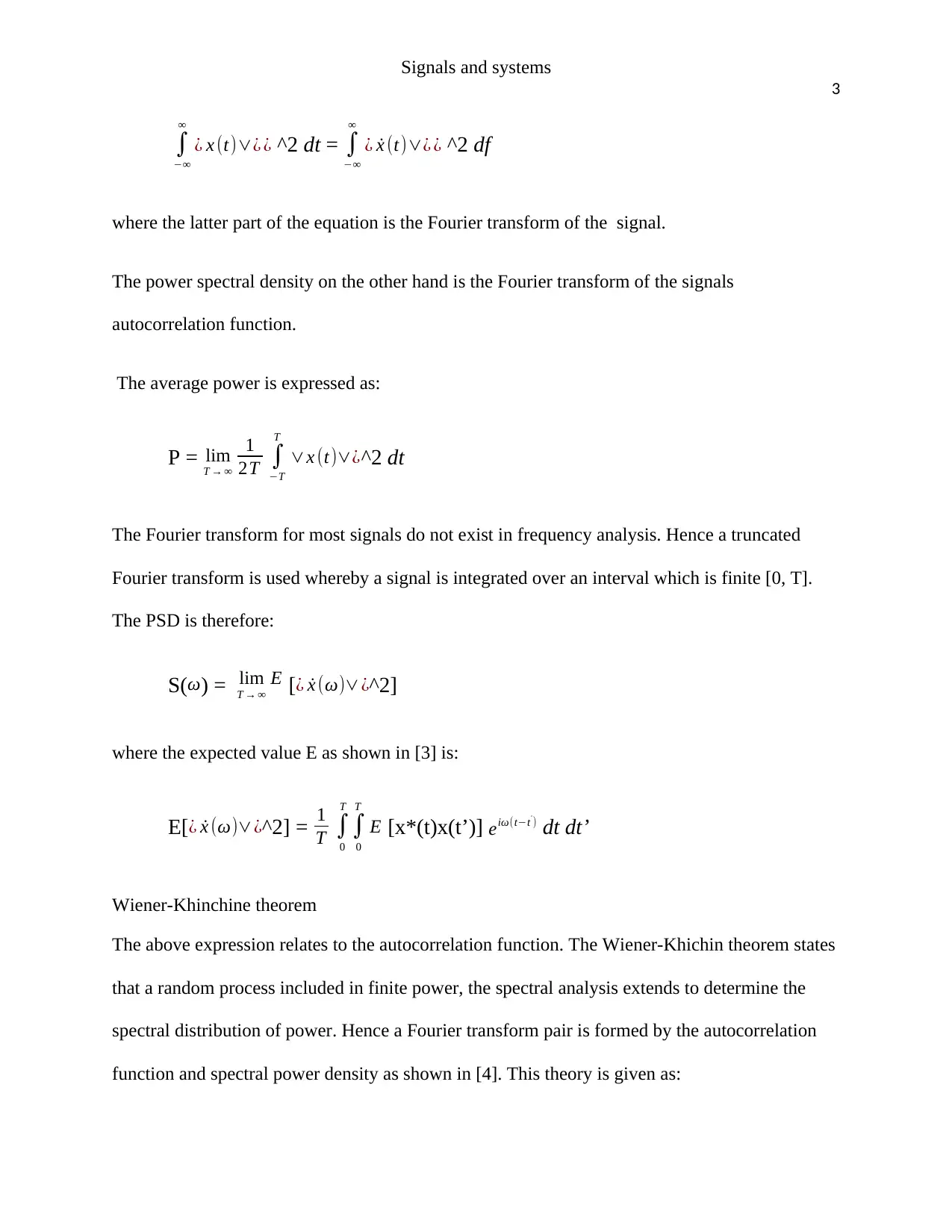
Signals and systems
3
∫
−∞
∞
¿ x (t)∨¿ ¿ ^2 dt = ∫
−∞
∞
¿ ẋ (t)∨¿ ¿ ^2 df
where the latter part of the equation is the Fourier transform of the signal.
The power spectral density on the other hand is the Fourier transform of the signals
autocorrelation function.
The average power is expressed as:
P = lim
T → ∞
1
2T ∫
−T
T
∨x (t)∨¿^2 dt
The Fourier transform for most signals do not exist in frequency analysis. Hence a truncated
Fourier transform is used whereby a signal is integrated over an interval which is finite [0, T].
The PSD is therefore:
S(ω) = lim
T → ∞
E [¿ ẋ (ω)∨¿^2]
where the expected value E as shown in [3] is:
E[¿ ẋ (ω)∨¿^2] = 1
T ∫
0
T
∫
0
T
E [x*(t)x(t’)] eiω(t−t' ) dt dt’
Wiener-Khinchine theorem
The above expression relates to the autocorrelation function. The Wiener-Khichin theorem states
that a random process included in finite power, the spectral analysis extends to determine the
spectral distribution of power. Hence a Fourier transform pair is formed by the autocorrelation
function and spectral power density as shown in [4]. This theory is given as:
3
∫
−∞
∞
¿ x (t)∨¿ ¿ ^2 dt = ∫
−∞
∞
¿ ẋ (t)∨¿ ¿ ^2 df
where the latter part of the equation is the Fourier transform of the signal.
The power spectral density on the other hand is the Fourier transform of the signals
autocorrelation function.
The average power is expressed as:
P = lim
T → ∞
1
2T ∫
−T
T
∨x (t)∨¿^2 dt
The Fourier transform for most signals do not exist in frequency analysis. Hence a truncated
Fourier transform is used whereby a signal is integrated over an interval which is finite [0, T].
The PSD is therefore:
S(ω) = lim
T → ∞
E [¿ ẋ (ω)∨¿^2]
where the expected value E as shown in [3] is:
E[¿ ẋ (ω)∨¿^2] = 1
T ∫
0
T
∫
0
T
E [x*(t)x(t’)] eiω(t−t' ) dt dt’
Wiener-Khinchine theorem
The above expression relates to the autocorrelation function. The Wiener-Khichin theorem states
that a random process included in finite power, the spectral analysis extends to determine the
spectral distribution of power. Hence a Fourier transform pair is formed by the autocorrelation
function and spectral power density as shown in [4]. This theory is given as:
⊘ This is a preview!⊘
Do you want full access?
Subscribe today to unlock all pages.

Trusted by 1+ million students worldwide
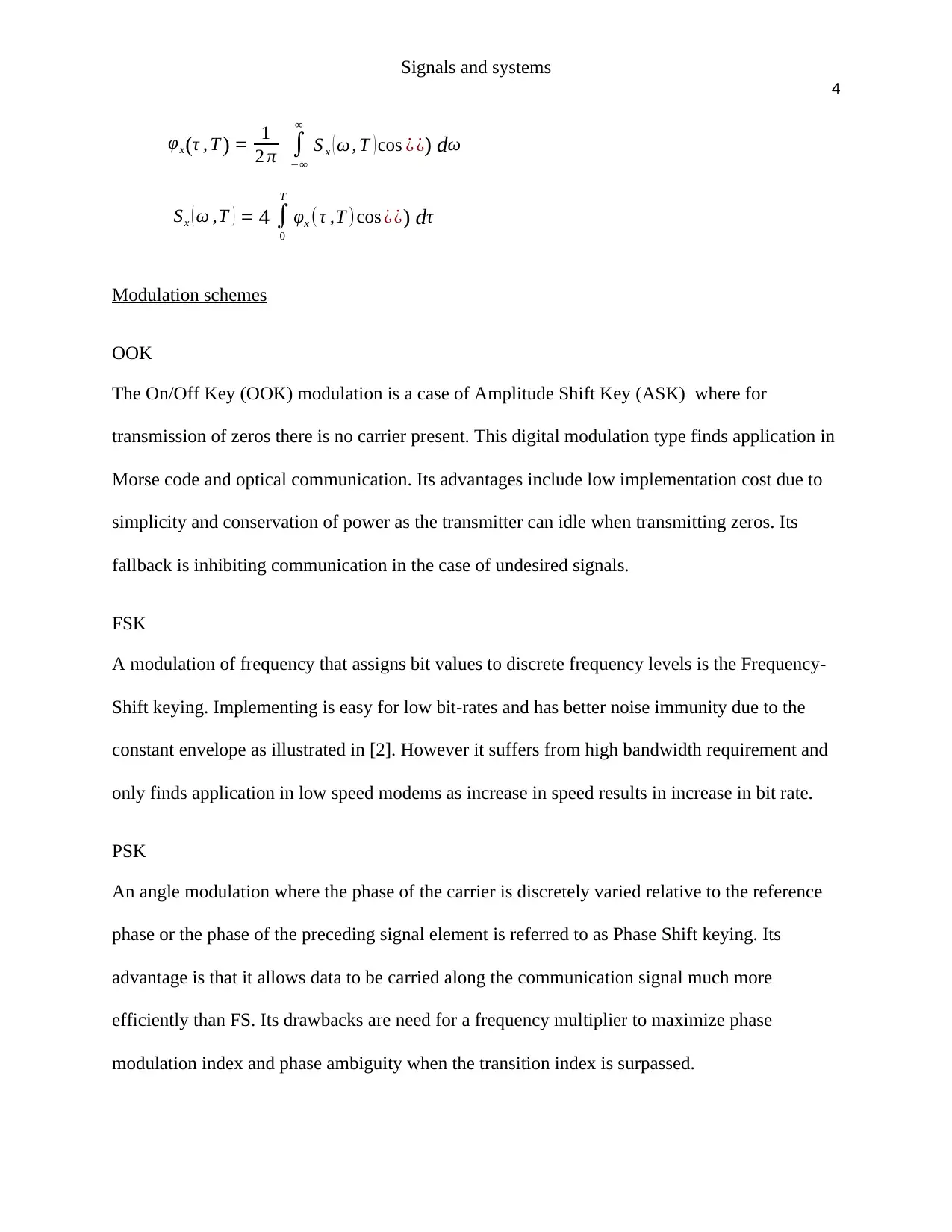
Signals and systems
4
φx(τ , T ) = 1
2 π ∫
−∞
∞
S x ( ω , T ) cos ¿ ¿) dω
Sx ( ω ,T ) = 4 ∫
0
T
φx ( τ ,T )cos ¿ ¿) dτ
Modulation schemes
OOK
The On/Off Key (OOK) modulation is a case of Amplitude Shift Key (ASK) where for
transmission of zeros there is no carrier present. This digital modulation type finds application in
Morse code and optical communication. Its advantages include low implementation cost due to
simplicity and conservation of power as the transmitter can idle when transmitting zeros. Its
fallback is inhibiting communication in the case of undesired signals.
FSK
A modulation of frequency that assigns bit values to discrete frequency levels is the Frequency-
Shift keying. Implementing is easy for low bit-rates and has better noise immunity due to the
constant envelope as illustrated in [2]. However it suffers from high bandwidth requirement and
only finds application in low speed modems as increase in speed results in increase in bit rate.
PSK
An angle modulation where the phase of the carrier is discretely varied relative to the reference
phase or the phase of the preceding signal element is referred to as Phase Shift keying. Its
advantage is that it allows data to be carried along the communication signal much more
efficiently than FS. Its drawbacks are need for a frequency multiplier to maximize phase
modulation index and phase ambiguity when the transition index is surpassed.
4
φx(τ , T ) = 1
2 π ∫
−∞
∞
S x ( ω , T ) cos ¿ ¿) dω
Sx ( ω ,T ) = 4 ∫
0
T
φx ( τ ,T )cos ¿ ¿) dτ
Modulation schemes
OOK
The On/Off Key (OOK) modulation is a case of Amplitude Shift Key (ASK) where for
transmission of zeros there is no carrier present. This digital modulation type finds application in
Morse code and optical communication. Its advantages include low implementation cost due to
simplicity and conservation of power as the transmitter can idle when transmitting zeros. Its
fallback is inhibiting communication in the case of undesired signals.
FSK
A modulation of frequency that assigns bit values to discrete frequency levels is the Frequency-
Shift keying. Implementing is easy for low bit-rates and has better noise immunity due to the
constant envelope as illustrated in [2]. However it suffers from high bandwidth requirement and
only finds application in low speed modems as increase in speed results in increase in bit rate.
PSK
An angle modulation where the phase of the carrier is discretely varied relative to the reference
phase or the phase of the preceding signal element is referred to as Phase Shift keying. Its
advantage is that it allows data to be carried along the communication signal much more
efficiently than FS. Its drawbacks are need for a frequency multiplier to maximize phase
modulation index and phase ambiguity when the transition index is surpassed.
Paraphrase This Document
Need a fresh take? Get an instant paraphrase of this document with our AI Paraphraser
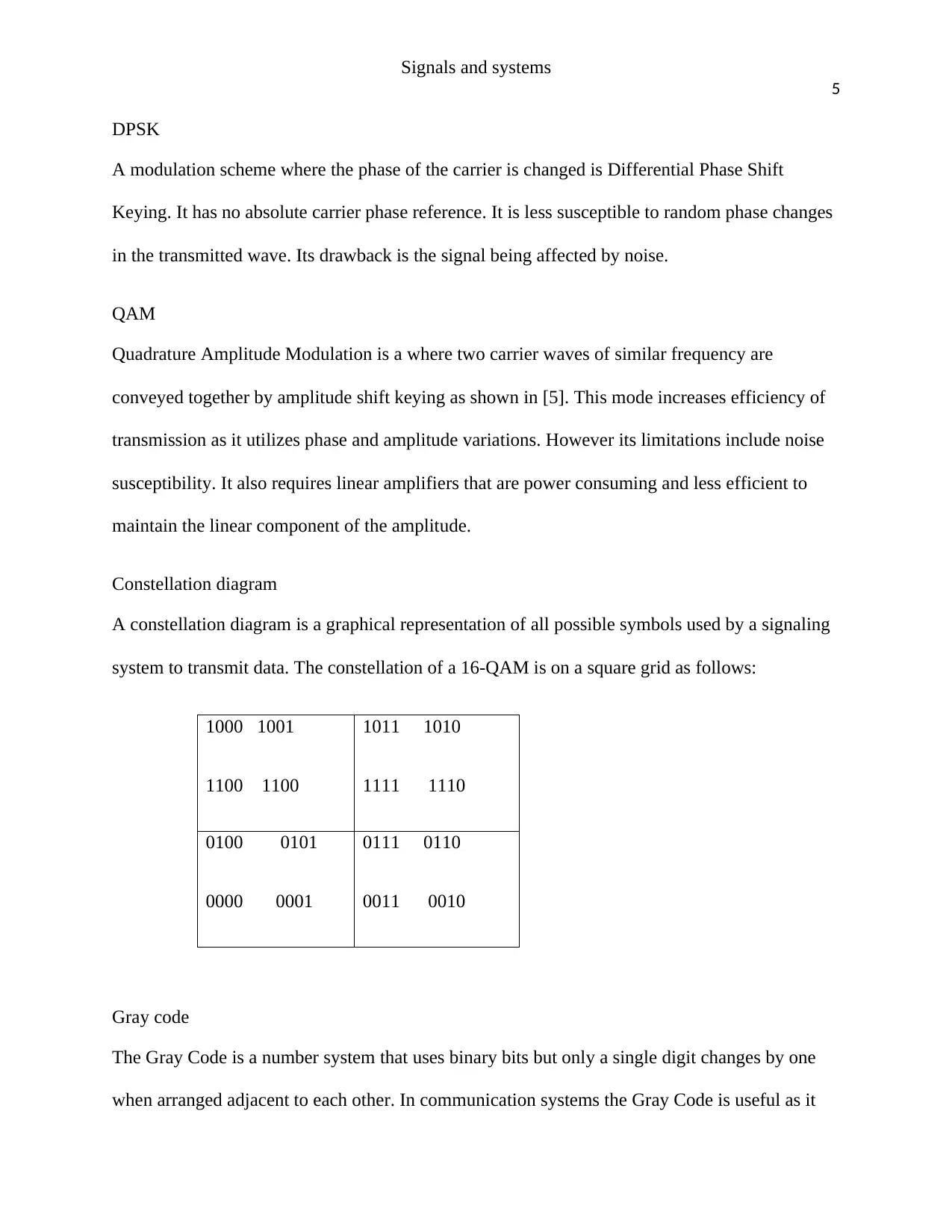
Signals and systems
5
DPSK
A modulation scheme where the phase of the carrier is changed is Differential Phase Shift
Keying. It has no absolute carrier phase reference. It is less susceptible to random phase changes
in the transmitted wave. Its drawback is the signal being affected by noise.
QAM
Quadrature Amplitude Modulation is a where two carrier waves of similar frequency are
conveyed together by amplitude shift keying as shown in [5]. This mode increases efficiency of
transmission as it utilizes phase and amplitude variations. However its limitations include noise
susceptibility. It also requires linear amplifiers that are power consuming and less efficient to
maintain the linear component of the amplitude.
Constellation diagram
A constellation diagram is a graphical representation of all possible symbols used by a signaling
system to transmit data. The constellation of a 16-QAM is on a square grid as follows:
1000 1001
1100 1100
1011 1010
1111 1110
0100 0101
0000 0001
0111 0110
0011 0010
Gray code
The Gray Code is a number system that uses binary bits but only a single digit changes by one
when arranged adjacent to each other. In communication systems the Gray Code is useful as it
5
DPSK
A modulation scheme where the phase of the carrier is changed is Differential Phase Shift
Keying. It has no absolute carrier phase reference. It is less susceptible to random phase changes
in the transmitted wave. Its drawback is the signal being affected by noise.
QAM
Quadrature Amplitude Modulation is a where two carrier waves of similar frequency are
conveyed together by amplitude shift keying as shown in [5]. This mode increases efficiency of
transmission as it utilizes phase and amplitude variations. However its limitations include noise
susceptibility. It also requires linear amplifiers that are power consuming and less efficient to
maintain the linear component of the amplitude.
Constellation diagram
A constellation diagram is a graphical representation of all possible symbols used by a signaling
system to transmit data. The constellation of a 16-QAM is on a square grid as follows:
1000 1001
1100 1100
1011 1010
1111 1110
0100 0101
0000 0001
0111 0110
0011 0010
Gray code
The Gray Code is a number system that uses binary bits but only a single digit changes by one
when arranged adjacent to each other. In communication systems the Gray Code is useful as it
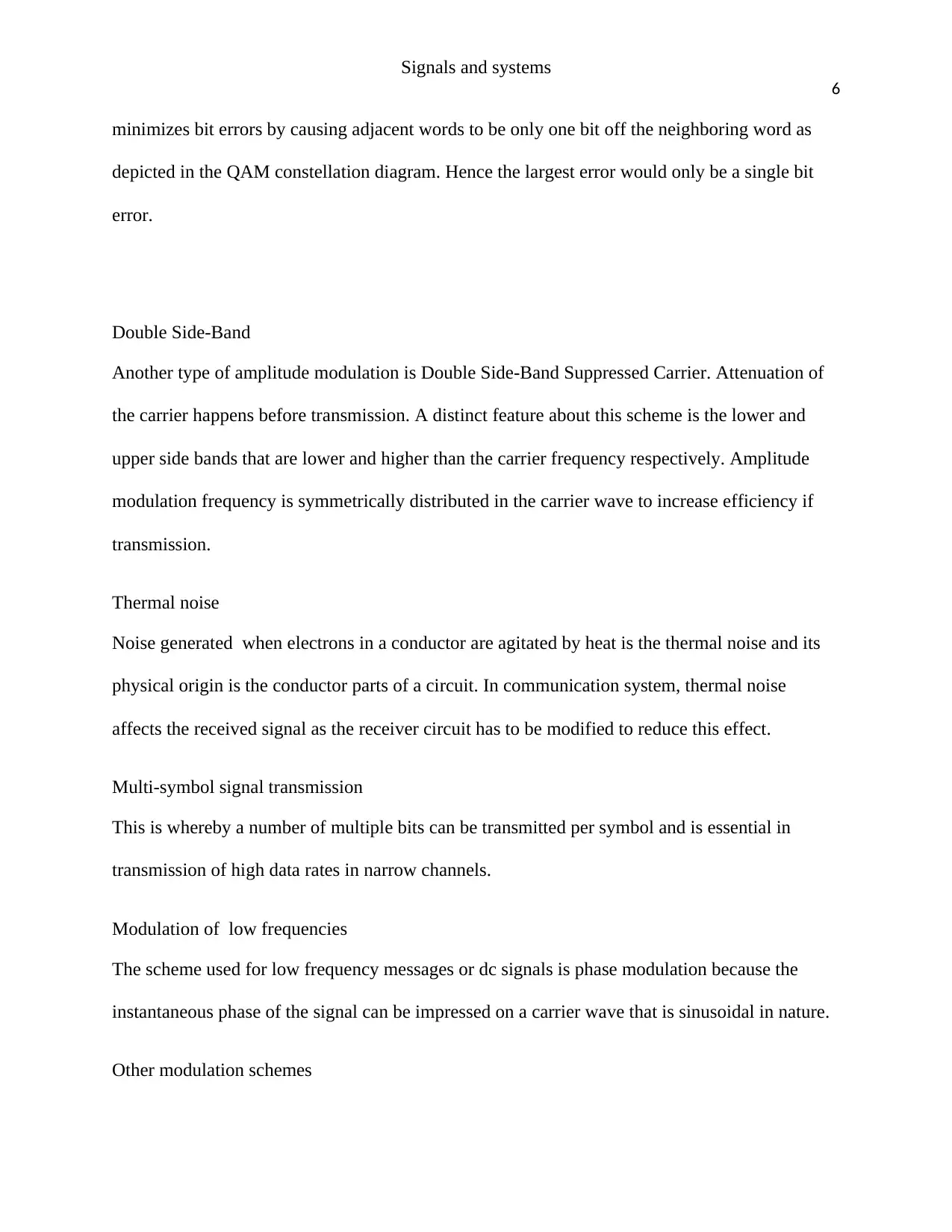
Signals and systems
6
minimizes bit errors by causing adjacent words to be only one bit off the neighboring word as
depicted in the QAM constellation diagram. Hence the largest error would only be a single bit
error.
Double Side-Band
Another type of amplitude modulation is Double Side-Band Suppressed Carrier. Attenuation of
the carrier happens before transmission. A distinct feature about this scheme is the lower and
upper side bands that are lower and higher than the carrier frequency respectively. Amplitude
modulation frequency is symmetrically distributed in the carrier wave to increase efficiency if
transmission.
Thermal noise
Noise generated when electrons in a conductor are agitated by heat is the thermal noise and its
physical origin is the conductor parts of a circuit. In communication system, thermal noise
affects the received signal as the receiver circuit has to be modified to reduce this effect.
Multi-symbol signal transmission
This is whereby a number of multiple bits can be transmitted per symbol and is essential in
transmission of high data rates in narrow channels.
Modulation of low frequencies
The scheme used for low frequency messages or dc signals is phase modulation because the
instantaneous phase of the signal can be impressed on a carrier wave that is sinusoidal in nature.
Other modulation schemes
6
minimizes bit errors by causing adjacent words to be only one bit off the neighboring word as
depicted in the QAM constellation diagram. Hence the largest error would only be a single bit
error.
Double Side-Band
Another type of amplitude modulation is Double Side-Band Suppressed Carrier. Attenuation of
the carrier happens before transmission. A distinct feature about this scheme is the lower and
upper side bands that are lower and higher than the carrier frequency respectively. Amplitude
modulation frequency is symmetrically distributed in the carrier wave to increase efficiency if
transmission.
Thermal noise
Noise generated when electrons in a conductor are agitated by heat is the thermal noise and its
physical origin is the conductor parts of a circuit. In communication system, thermal noise
affects the received signal as the receiver circuit has to be modified to reduce this effect.
Multi-symbol signal transmission
This is whereby a number of multiple bits can be transmitted per symbol and is essential in
transmission of high data rates in narrow channels.
Modulation of low frequencies
The scheme used for low frequency messages or dc signals is phase modulation because the
instantaneous phase of the signal can be impressed on a carrier wave that is sinusoidal in nature.
Other modulation schemes
⊘ This is a preview!⊘
Do you want full access?
Subscribe today to unlock all pages.

Trusted by 1+ million students worldwide
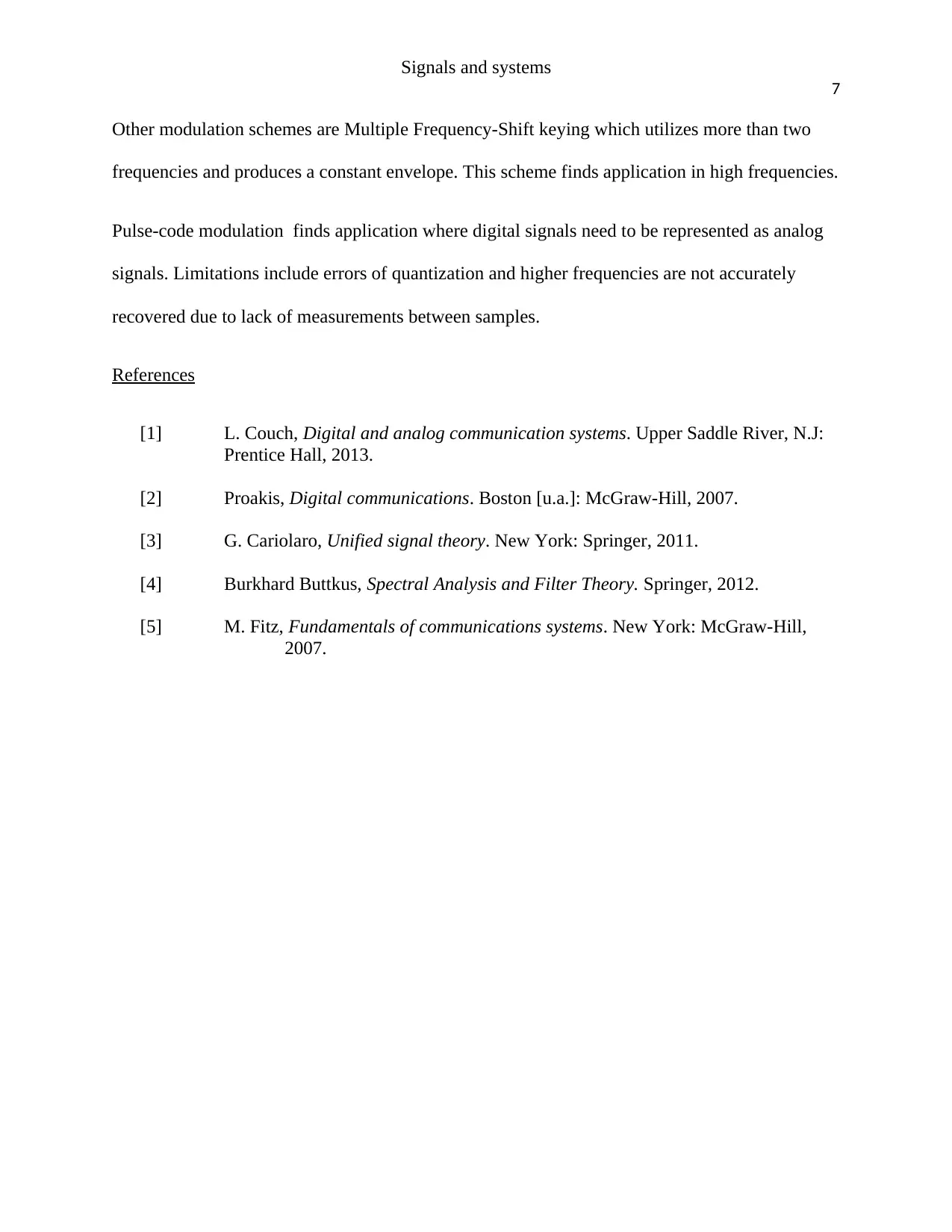
Signals and systems
7
Other modulation schemes are Multiple Frequency-Shift keying which utilizes more than two
frequencies and produces a constant envelope. This scheme finds application in high frequencies.
Pulse-code modulation finds application where digital signals need to be represented as analog
signals. Limitations include errors of quantization and higher frequencies are not accurately
recovered due to lack of measurements between samples.
References
[1] L. Couch, Digital and analog communication systems. Upper Saddle River, N.J:
Prentice Hall, 2013.
[2] Proakis, Digital communications. Boston [u.a.]: McGraw-Hill, 2007.
[3] G. Cariolaro, Unified signal theory. New York: Springer, 2011.
[4] Burkhard Buttkus, Spectral Analysis and Filter Theory. Springer, 2012.
[5] M. Fitz, Fundamentals of communications systems. New York: McGraw-Hill,
2007.
7
Other modulation schemes are Multiple Frequency-Shift keying which utilizes more than two
frequencies and produces a constant envelope. This scheme finds application in high frequencies.
Pulse-code modulation finds application where digital signals need to be represented as analog
signals. Limitations include errors of quantization and higher frequencies are not accurately
recovered due to lack of measurements between samples.
References
[1] L. Couch, Digital and analog communication systems. Upper Saddle River, N.J:
Prentice Hall, 2013.
[2] Proakis, Digital communications. Boston [u.a.]: McGraw-Hill, 2007.
[3] G. Cariolaro, Unified signal theory. New York: Springer, 2011.
[4] Burkhard Buttkus, Spectral Analysis and Filter Theory. Springer, 2012.
[5] M. Fitz, Fundamentals of communications systems. New York: McGraw-Hill,
2007.
1 out of 7
Your All-in-One AI-Powered Toolkit for Academic Success.
+13062052269
info@desklib.com
Available 24*7 on WhatsApp / Email
![[object Object]](/_next/static/media/star-bottom.7253800d.svg)
Unlock your academic potential
Copyright © 2020–2025 A2Z Services. All Rights Reserved. Developed and managed by ZUCOL.


